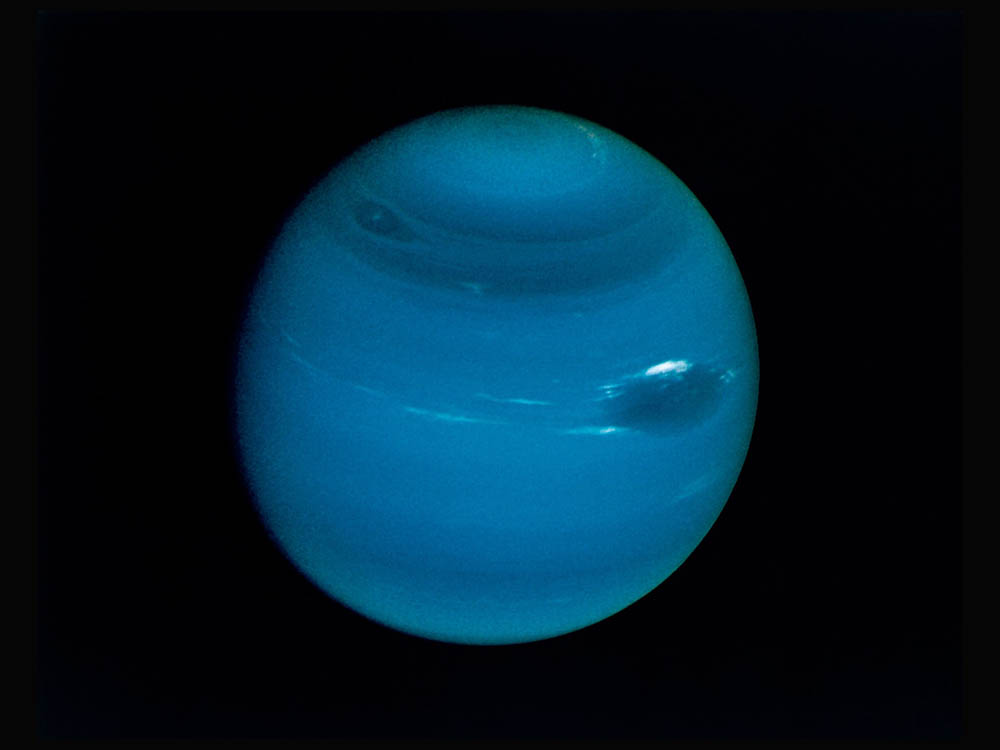How Did Neptune Get Its Name? What is the Meaning of Neptune?
Last Updated on

Neptune differs from most planets in the Solar System. Like Uranus, it can’t be seen with the naked eye and, thus, wasn’t known by humans for quite some time. We know far less about Neptune than the other planets in the Solar System.
After all, Neptune is 2,781,019,860 miles1 from the Sun compared to Earth only being 93,841,948 miles2 away. That is nearly 30 times farther. To put this in perspective, while sunlight takes over 4 hours and 13 minutes to reach Neptune, it only takes 8.4 minutes to reach the Earth.
Because we don’t know a whole lot about this planet, it makes people wonder how we even came up with its name. There were several name ideas thrown around by scientists, but it was first given its name after the God of the Sea after it was first discovered.

Discovery of Neptune
While we can’t see it in the night sky, Neptune is nearly four times larger than the Earth. Thanks to Galileo, we confirmed the existence of five visible planets long ago. He suspected Neptune’s place in the sky as a star in 1613. It wouldn’t be formally discovered until 1846 when Urbain Le Verrier deduced its position mathematically. Johann Gottfried Galle later confirmed Le Verrier’s calculations.
Galle also observed Triton, one of 14 of Neptune’s moons. Neptune became the farthest planet in our galaxy until Clyde Tombaugh identified Pluto on February 18, 1930. It retained this status until it lost its place among the planets on August 24, 2006. Now, Neptune has claimed this spot as the farthest known planet in our Solar System.

The Meaning of Neptune
As you can imagine, the discovery of a new planet was a momentous occasion. Scientists proposed several names for it until the consensus settled on Neptune. The official naming of all things celestial is the province of the United Nation’s International Astronomical Union (IAU). The organization was formed in 1919.
The names of many celestial bodies, including Neptune, were widely accepted before the IAU. It became official in 1976 at the XVIth General Assembly of the IAU.
The word “Neptune” comes from Latin, meaning the “Roman god of the sea.” Poseidon is the Greek equivalent. The adjective “Neptunian” is equally fitting as a geological term for actions carried out by water. It may refer to the violent winds that occur on the planet that can reach speeds over 1,300 mph. It may also pertain to the icy, semi-fluid mantle surrounding its solid, rocky core.
Characteristics and Exploration of Neptune
Neptune differs from the Earth in many ways. Unlike the Earth, Mars, Mercury, and Venus, it is not a terrestrial planet. You couldn’t walk on its surface because it doesn’t exist. Its atmosphere is a stark contrast to the mix of nitrogen and oxygen on Earth. Instead, Neptune consists primarily of hydrogen and helium.
Life isn’t possible on Neptune with the extreme environmental challenges. The planet has five rings, the first evidence of which was discovered in 1984.
While a single day is 16 hours, a Neptunian year is nearly 165 years. That means that Neptune has only rotated around the Sun once since its discovery in 1846.
NASA’s Voyager 2 was the only spacecraft to get anywhere near Neptune, and even that was 2,983 miles away. Nevertheless, it was the first to ever make this journey. It confirmed the existence of the planet’s ring system and provided additional details about its moons and their surfaces. Future missions are necessary and currently being planned in order to learn more about this icy giant.
In 2019, the NASA Outer Planets Assessment Group (OPAG) Roadmaps to Ocean Worlds (ROW) group identified Neptune’s moon, Triton, as a prime candidate for further exploration of ocean worlds. Perhaps we can discover more of its elusive secrets in the not-so-distant future.


Conclusion
Much remains to be learned about the most distant planet in our Solar System. Thankfully, there are opportunities to explore the galaxy and these so-called ocean worlds further. It makes us excited to learn more about Neptune and what this secretive planet has to offer.
Featured Image Credit By: NASA, Unsplash
About the Author Chris Dinesen Rogers
Chris has been writing since 2009 on a variety of topics. Her motto with all of her writing is “science-based writing nurtured by education and critical thinking.” Chris specializes in science topics and has a special love for health and environmental topics, and animals of all shapes and sizes.
Related Articles:
How to Clean a Refractor Telescope: Step-by-Step Guide
How to Clean a Telescope Eyepiece: Step-by-Step Guide
How to Clean a Rifle Scope: 8 Expert Tips
Monocular vs Telescope: Differences Explained (With Pictures)
What Is a Monocular Used For? 8 Common Functions
How to Clean a Telescope Mirror: 8 Expert Tips
Brightfield vs Phase Contrast Microscopy: The Differences Explained
SkyCamHD Drone Review: Pros, Cons, FAQ, & Verdict
